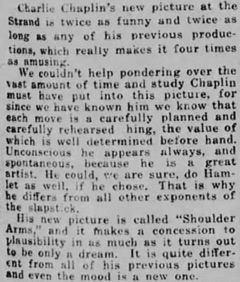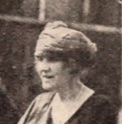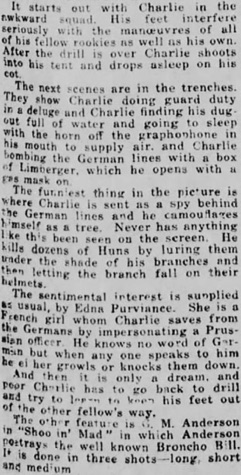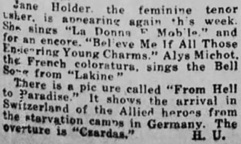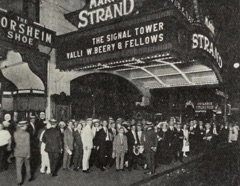Shoulder Arms 1914 1919 next previous
Shoulder Arms Clippings 78/246
Harriette Underhill, New York Tribune, New York, October 22, 1918.
Harriette Underhill
(...) Photo, Exhibitors Herald, April 21, 1923, detail
& Strand Theatre, exterior by night, marquee
THE SIGNAL TOWER VALLI W. BEERY & FELLOWS,
New York – Despite a scorching, mid-summer
heat wave, the Universal Jewel did excellent business during
its run at the Mark Strand, New York City.
(...) Photo, Universal Weekly, Aug. 16, 1924
„He camouflages himself as a tree“
Editorial content. „On the Screen
Charlie Chaplin Surpassed All Former Fun Making
Marks in Shoulder Arms
Charlie Chaplin‘s new picture at the Strand is twice as funny
and twice as long as any of his previous productions,
which really makes it four times as amusing.
We couldn‘t help pondering over the vast amount of time
and study Chaplin must have put into this picture,
for since we have known him we know that each move
is a carefully planned and carefully rehearsed
thing, the value of which is well determined before hand.
Unconscious he appears always, and spontaneous,
because he is a great artist. He could, we are sure, do Hamlet
as well, if he chose. That is why he differs from all
other exponents of the slapstick.
His new picture is called Shoulder Arms, and it makes
a concession to plausibility in as much as it turns
out to be only a dream. It is quite different from all of his
previous pictures and even the mood is a new one.
It starts out with Charlie in the awkward squad. His feet
interfere seriously with the manœuvres of all of his
fellow rookies as well as his own. After the drill is over Charlie
shoots into his tent and drops asleep on his cot.
The next scenes are in the trenches. They show Charlie
doing guard duty in a deluge and Charlie finding his
dugout full of water and going to sleep with the horn off the
graphophone in his mouth to supply air, and Charlie
bombing the German lines with a box of Limburger, which
he opens with a gas mask on.
The funniest thing in the picture is where Charlie is sent
as a spy behind the German lines and he camouflages
himself as a tree. Never has anything like this been seen on the
screen. He kills dozens of Huns by luring them under
the shade of his branches and then letting the branch fall
on their helmets.
The sentimental interest is supplied as usual, by Edna
Purviance. She is a French girl whom Charlie saves
from the Germans by impersonating a Prussian officer. He knows
no word of German but when any one speaks to him
he either growls or knocks them down.
And then it is only a dream, and poor Charlie
has to go back to drill and try to learn
to keep his feet out of the other fellow‘s way.
The other feature is G. M. Anderson in „Shootin‘ Mad“
in which Anderson portrays the well known
Broncho Bill. It is done in three shots – long, short and medium.
Jane Holder, the feminine tenor usher, is appearing
again this week. She sings „La Donna E Mobile,“ and for an
encore, „Believe Me If All Those Endearing Young
Charms.“ Alys Michot, the French coloratura, sings the Bell
Song from „Lakme.“
There is a picture called „From Hell to Paradise.“
It shwos the arrival in Switzerland of the Allied
heroes from the starvation camps in Germany. The overture
is „Czardas.“ „H. U.“
H. U. is Harriette Underhill.
„Lakme,“ Delibes‘ opera, is written „Lakine.“
Strand Theatre, Broadway and 47th Street, New York.
Shoulder Arms has a pre-release presentation
at the Strand Theatre, starting Sunday, October 20, 1918,
Chaplin‘s film is released by First National
October 27, 1918.
Redaktioneller Inhalt
Shoulder Arms 1914 1919 next previous


